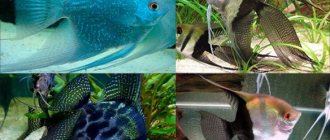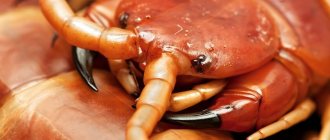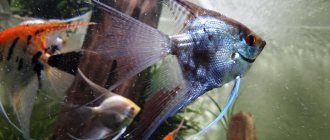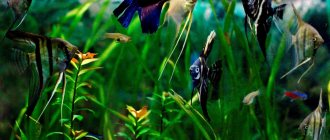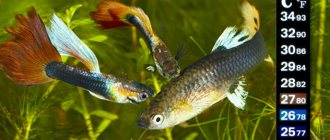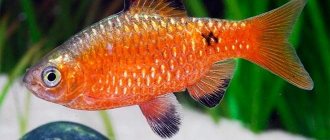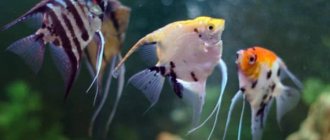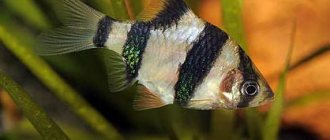Aquarium fish angelfish photo and description
Angelfish are the most common aquarium fish of the cichlid family, which are not only very beautiful, but also have unusual behavior that distinguishes them from others. There are three types of angelfish:
- The common angelfish has a classic body shape of a silvery color with four transverse stripes;
- Angelfish altum or tall-bodied, characterized by an elongated body - some grow up to 30 cm in height;
- Leopold's angelfish is a small species with an aggressive disposition.
- golden green, smoky, striped, black,
- two-color (bicolor);
- tricolor (Koi).
- lace;
- zebra;
- train or veil;
- black;
- gold;
- blue;
- marble;
- Red Devil;
- pearl or diamond;
- chocolate;
- white;
- Pinoy (Pinoy Zebra);
- Dantum Albino.
Aquarium fish Angelfish are not very whimsical, slow and graceful. They are very curious by nature and will watch with interest what is happening in the aquarium. They have a developed intellect and treat their offspring with care. If you walk into a room, they will certainly react to you.
Table of basic parameters of maintenance, care and nutrition:
| What should be the volume of an aquarium for Angelfish? | from 100 liters for a flock from 150 liters |
| What should be the temperature in the aquarium for Angelfish? | from +25-28° C |
| What pH should be in the aquarium? | from 5.5-7.5 pH |
| What should be the hardness of the water in the aquarium? | from 5-15° dH |
| What should be the substrate for an aquarium? | small pebbles or coarse sand suitable for living plantings |
| What kind of lighting should be in the aquarium? | moderate and daylight hours at least 12 hours |
| What should be the movement of water in the aquarium? | moderate |
| Maximum fish size | length up to 15 cm. Height from 26-30 cm (a lot depends on the volume of the aquarium) |
| What does aquarium fish eat? | almost any live food: bloodworms, adult brine shrimp, coretra, tubifex and specialized dry food |
| Type of aquarium fish | peaceful, but small fish and shrimp can become food for them |
| Who is compatible with in an aquarium? | compatible with all peaceful ones that do not fit in the mouth |
| Lifespan of an angelfish | in aquariums they live up to about 10 years, but with proper care up to 20 years |
Description and habitat
Angelfish are fish of the Cichlid family. The “Freshwater Angel” is distinguished by a disc-shaped, high, laterally compressed body shape. Height up to 25 cm, length up to 15 cm. The caudal and pectoral fins are pointed at the end, the ventral fins look like threads, the dorsal and anal fins are elongated because of this the fish looks like a crescent.
The natural color is olive-gray, with black stripes across and a silver tint. The back is darker than the belly. Breeders selected individuals with different color options: green, gold, white, olive, marbled, red, blue, multi-colored. The scales of the fish are small. The difference between male and female is weakly expressed.
The homeland of the angelfish is the Amazon, tributaries of Peru, Brazil, and Ecuador. They swim in the basins of the Orinoco and Essequibo rivers. They love bodies of water with slow currents and dense reed vegetation. It has been bred in aquariums since the last century.
How to care for Angelfish in an aquarium at home
Considering the size of this aquarium fish , to keep it you need to purchase a spacious aquarium - at least 100 liters, but if you keep a flock, then the aquarium should be 150 liters or more. It is necessary that there is enough space for free swimming.
Contents Angelfish cannot be called complex. Considering that these are tropical fish, you need to maintain a water temperature of 25-28° C. Optimal acidity is approximately 5.5-7.5 pH, hardness is 5-15° dH. They live only in aquariums with aeration and filtration. You also need to turn on the compressor twice a day for 20-30 minutes and change the settled water weekly, in a volume of 30%. They like moderate lighting, as they are shy when bright lights are turned on. Thickets of Vallisneria will create an imitation of the natural habitat. Angelfish do not need shelter.
Requirements for the reservoir
Angelfish in an aquarium require slightly special conditions due to the structural features of their body. A minimum of 100 liters of water should be in the home pond to keep the angelfish in conditions favorable to them. For several individuals, it is better to prepare an aquarium of at least 200 liters.
Although angelfish belong to the cichlid genus, they do not show aggression and get along calmly with many other species. You can add aquarium fish to them, such as swordtails or tetras, all types of catfish, tetras, lalius, gouramis, and small eels. It is possible that other cichlids exist with angelfish, but only those that do not show aggression.
Read more about the compatibility of angelfish with other fish in a separate article.
It is not recommended to keep angelfish in an aquarium together with baby guppies or neons, which will be eaten at the first opportunity, as well as with goldfish.
Angelfish
Discus fish, which at first glance are related, will also not be able to exist together. The water temperature in the aquarium is different for both individuals. Adult discus grow larger and will require more water.
Aquarium for angelfish - basic requirements:
- Volume of at least 100 liters.
- The temperature for angelfish is comfortable within 22–27 °C.
- A filter and compressor are required.
- Change one quarter of the water weekly.
- Lack of direct and bright light. It is good to plant tall plants that create partial shade.
- Creating the possibility of free swimming.
There is no need to provide shelter for angelfish. Aquarium science characterizes this species as easy to keep and the best option for beginners keeping a home pond.
Interesting! For the peculiarity of the body structure and the shape of the fins in the West, angelfish are called Angels.
What to feed Angelfish
Angelfish do not require special nutrition. They perfectly consume almost any live food: bloodworms, adult brine shrimp, coretra, tubifex.
It is better to feed angelfish with frozen food, but the food must be brought to room temperature before feeding. Finely chopped ground beef or seafood, specialized dry food, which can be purchased at any pet store, are also suitable.
It is better to feed the fish 2-3 times a day little by little, while making sure that the food is eaten within 1-2 minutes, otherwise overfeeding may occur, which will worsen the health or even contribute to the death of the Angelfish. It is also useful to give your pets “fasting days” once a week - feed them only plant foods.
Maintenance and care in the aquarium
Keeping and caring for angelfish requires special attention. Place the artificial pond in a quiet place, covering it with a lid. Individuals are shy, afraid of unnecessary noise and shadows. They are kept in groups, in a free aquarium, at least 150 liters per couple. The water must be clean, slightly acidic, temperature + 24…+26 °C. Filtration is moderate, water changes are 20% every week.
The food is suitable: daphnia, bloodworms, coretra, good quality dry flakes, frozen minced seafood. It is inconvenient for the fish to pick up food from the bottom, so a small feeder is installed inside the aquarium.
You should not overfeed, otherwise the angelfish will become lethargic and inactive.
Include spirulina and animal protein in your diet. Give food 2-3 times a day.
The light is muted, without a sharp change of day and night. Plants create a natural habitat, shade bright light, and shy fish feel protected. They use nymphea or water lily, echinodorus, vallisneria, rootless wolfia, lemongrass, and water ferns. Place coarse sand and fine gravel on the bottom. Decorate with rocks, driftwood, without sharp objects.
The fry require food 8-14 days after emergence. Usually these are brine shrimp. The lifespan of an angelfish is 3 years, but with proper care it can reach 10 years.
How to distinguish a male Angelfish from a female
It is sometimes difficult to distinguish the sex of a given fish and is only possible when they become sexually mature - at 8-12 months. When buying young animals, you clearly cannot distinguish a male from a female, but the larger ones will probably turn out to be males.
The main distinguishing feature is that males have a fatty bump on their forehead, while female Angelfish do not. Also, in pairs, males are more active, but this is not a clear distinguishing feature, because sometimes females also imitate the behavior of the male.
How do angelfish reproduce?
Angelfish form a monogamous pair and are faithful to their partner. They can spawn directly in the aquarium. When a pair of Angelfish plans to reproduce, they stay together, drive away other fish and clean the place they have chosen for spawning. They spawn every 7-10 weeks. In this case, the female lays several hundred eggs on leaves, pieces of driftwood, and even on the glass of the aquarium, after which the male fertilizes them. Next, larvae appear, which after some time become fry.
In addition to all their advantages, Angelfish are also caring parents who not only look after their eggs, but also the hatched fry.
Care and maintenance
Angelfish is an unpretentious species that lives 10 years or more provided comfortable living conditions are provided. Due to their shape, it is necessary to give preference to tall aquariums with a volume of 120 liters or more. This point should also be taken into account because the more space there is for fish, the less likely it is that they will eat their eggs.
Angelfish feels comfortable in warm water (about 25-27 degrees). This is where their usual habitat comes into play - slightly acidic, fairly soft and warm water . However, thanks to the achievements of modern science, it can easily adapt to any living conditions. As for the decor, you should avoid the presence of sharp edges that could injure the fish. Eggs are laid on the wide leaves of underwater plants, so for this you can plant a nymph or Amazon on the bottom.
Due to the peculiarity of the body structure of the angelfish (they do not swim in strong currents), moderate filtration should be used in the aquarium. When there is a large flow of water, the fish experience stress, which, in turn, affects their growth.
You can use an external filter and supply water using a flute, but if you only have an internal one, you need to add a flow sprayer to it. Once a week you need to change 20-25% of the water volume in the aquarium.
In this video you will learn more about this fish:
What fish get along with Angelfish in an aquarium?
Common angelfish are peaceful and calm, but due to their large size, it is undesirable to live next to small fish, which can become food for them. Angelfish get along well with a group of barbs, but if one or a couple of barbs are in the neighborhood, the Angelfish will probably have its fins bitten off.
All colorful peace-loving fish will be good neighbors - Gourami, Swordtails, Botia, catfish, Labeo and Tetras, pseudotropheus, Discus, Congo, erythrozonus. You cannot place bettas, Ternetius, Danios, and Guppies in the same aquarium of gold and fighting fish. Angelfish usually make good neighbors with fish of the same species.
Compatibility
Angels are fish with a calm character, however, cichlids can show aggression towards small angelfish fish, especially pets will happily eat shrimp and fry. You can keep the following fish in the same aquarium with angels:
- swordtails;
- platies;
- mollies;
- gourami;
- Congo and other calm medium-sized phenotypes.
You should avoid proximity to aggressive specimens that gnaw the fins of angels, or with small fish, for example:
- barbs;
- guppies and microrasboras;
- thorns;
- goldfish;
- Akara.
What diseases does Angelfish have?
Like any living creature, Angelfish are susceptible to various diseases. If your pet has an inflamed anus, then most likely it is hexamitosis, which means that parasites have settled in the body. It is important to provide timely treatment and place the sick fish separately.
In cases of severe glucose disease, the fish exhibits bilateral bulging eyes and white spots and bumps on the body. The disease usually leads to death. The fish needs to be removed urgently and the aquarium needs to be completely cleaned.
When infected with a rod-shaped bacterium, Angelfish become passive, the ends of the fins and side “fins” rot, a white coating appears on the body - fin rot, and the eyes become cloudy. Immediate treatment is required.
Angelfish are also susceptible to infection with saprolegnia molds. In this case, it is important to start treatment immediately, otherwise, if the fungus penetrates the internal organs, unfortunately, it will not be possible to save the pet.
